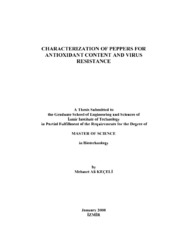Please use this identifier to cite or link to this item:
https://hdl.handle.net/11147/3918Full metadata record
| DC Field | Value | Language |
|---|---|---|
| dc.contributor.advisor | Doğanlar, Sami | - |
| dc.contributor.author | Keçeli, Mehmet Ali | - |
| dc.date.accessioned | 2014-07-22T13:52:40Z | - |
| dc.date.available | 2014-07-22T13:52:40Z | - |
| dc.date.issued | 2008 | - |
| dc.identifier.uri | http://hdl.handle.net/11147/3918 | - |
| dc.description | Thesis(Master)--Izmir Institute of Technology, Biotechnology, Izmir, 2008 | en_US |
| dc.description | Includes bibliographical references | en_US |
| dc.description | Text in English; Abstract: Turkish and English | en_US |
| dc.description | xii, 77 leaves | en_US |
| dc.description.abstract | In the first part of this study, total water soluble antioxidant activity, phenolic compounds and vitamin C content of 29 Turkish and 14 non-Turkish pepper cultivars were determined. Significant trait diversity was found in the cultivars with the most variation (7.4-fold) seen for total antioxidant capacity which ranged from 2565 to 18957 .mol Trolox/kg. Vitamin C content for the peppers ranged from 522 to 1631 mg/kg, a 3.1-fold difference, while total phenolic content for the pepper cultivars ranged from 607 to 2724 mg/kg, a 4.5-fold difference. A strong correlation between total antioxidant capacity and phenolic content (r . 0.71) was also seen. Significant variation for antioxidant content in Turkish germplasm indicates that this material can be used for improvement and genetic mapping of nutritional content in pepper. In the second part of this study, amplified fragment length polymorphism (AFLP), cleaved amplified polymorphism (CAPs) and simple sequence repeat (SSR) markers were used to map gene(s) for cucumber mosaic virus resistance. The mapping was conducted using a F2 population derived from a cross between Capsicum annuum cv. Jupiter (susceptible) X C. frutescens (resistant). The F2 population, consisting of 76 individuals, was screened with 13 AFLP primer pairs, 60 CAPs markers and 30 SSR markers to detect markers possibly linked to CMV resistance gene(s). As a result, 7 QTL were found which are related with resistance to CMV in pepper. This will provide pepper breeders an opportunity to use these markers for marker-assisted selection for CMV resistance in pepper. | en_US |
| dc.language.iso | en | en_US |
| dc.publisher | Izmir Institute of Technology | en_US |
| dc.rights | info:eu-repo/semantics/openAccess | en_US |
| dc.subject.lcc | TP248.27.P55 K261 2008 | en |
| dc.subject.lcsh | Plant biotechnology | en |
| dc.subject.lcsh | Medicinal plants--Biotechnology | en |
| dc.subject.lcsh | Peppers | en |
| dc.subject.lcsh | Antioxidants | en |
| dc.title | Characterization of Peppers for Antioxidant Content and Virus Resistance | en_US |
| dc.type | Master Thesis | en_US |
| dc.institutionauthor | Keçeli, Mehmet Ali | - |
| dc.department | Thesis (Master)--İzmir Institute of Technology, Bioengineering | en_US |
| dc.relation.publicationcategory | Tez | en_US |
| dc.identifier.wosquality | N/A | - |
| dc.identifier.scopusquality | N/A | - |
| item.openairecristype | http://purl.org/coar/resource_type/c_18cf | - |
| item.languageiso639-1 | en | - |
| item.openairetype | Master Thesis | - |
| item.grantfulltext | open | - |
| item.fulltext | With Fulltext | - |
| item.cerifentitytype | Publications | - |
| Appears in Collections: | Master Degree / Yüksek Lisans Tezleri | |
Files in This Item:
| File | Description | Size | Format | |
|---|---|---|---|---|
| T000723.pdf | MasterThesis | 1.75 MB | Adobe PDF |  View/Open |
CORE Recommender
Page view(s)
332
checked on Mar 31, 2025
Download(s)
84
checked on Mar 31, 2025
Google ScholarTM
Check
Items in GCRIS Repository are protected by copyright, with all rights reserved, unless otherwise indicated.